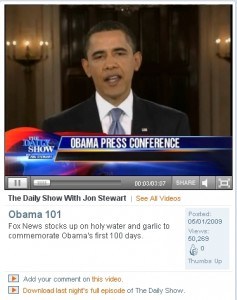We knew it was always come down to the question of what to do about online video. Although the overwhelming majority of broadband customers still take some sort of video package (or simply don’t care enough about television to get one in the first place), there is a small, but growing number of people who are dispensing with video packages from cable and relying entirely on broadband video services to watch network and cable programming.
Hulu and Joost, along with limited fare from the major American networks, as well as video offerings from the CBC and BBC exclusive to residents of those countries, create the potential for a major problem for cable operators — what happens if people stop buying video packages.
Comcast and Time Warner, the nation’s largest cable operators, have plans to put a stop to the erosion in video subscribers before it gets serious — by seeing to it that they don’t get to watch free online video any longer.
Comcast’s On Demand Online and Time Warner’s TV Everywhere services are either in operation or will begin trials later this year. Both seek arrangements with cable programmers (coincidentally many of which they also have an ownership interest in) to create a new authentication system to block non-video subscribers from accessing video content aired on those channels. Cable subscribers who do take a video package will get in for free.
The video programming would still exist on various cable network websites. Comedy Central would still have clips on comedycentral.com and CNN would still have their news clips at cnn.com. But under the cable operators’ proposals, those clips would no longer be available to individuals who cannot prove they have a video subscription.
Currently, some 90% of Time Warner’s broadband customers also take a video package, and Time Warner can easily authenticate those subscribers with a type of “authorization key” which an online video player would seek for permission to play the programming. Time Warner is also contemplating whether live streams of cable channels would also be a good idea. Currently, cable operators routinely insist on prohibiting live streaming of the cable networks they carry.
Of course, the problem will come down to those who subscribe via satellite dish services or a smaller cable operator or telephone company video package. Does this enforcement only occur on Time Warner and Comcast’s own broadband networks, or would it be widespread?
Multichannel News covered the Time Warner TV Everywhere trial:
Time Warner Cable is working with two major programming partners on its “TV Everywhere” initiative to make sure the Internet-video service is easy to use and scalable, said Peter Stern, the operator’s executive vice president and chief strategy officer.
Stern, speaking on a panel here at the Cable Show ’09, said the MSO is already working closely with two programmers — Turner Broadcasting System and another he did not identify — that will involve authenticating consumers “in a very straightforward way so they can get access to content.”
“To be honest, we’re still working it out in terms of the user experience,” Stern said.
The concept, which is being Comcast and Cox Communications, is to reinforce the cable TV subscription model, by providing that programming to paying customers over their Internet devices.
Stern pointed out that 90% of Time Warner Cable’s broadband customers are already paying for multichannel video.
“Those people are already entitled to watch this programming,” he said. “The big risk we have is, if we don’t offer this programming to them the way they want it, they’ll turn to piracy.”
Alternatively, if that programming is provided to them for free over the Internet, the risk is they’ll cancel their subscription service – with such “cord cutters” obtaining their media online.
Some basic principles Time Warner Cable is following in developing TV Everywhere are that consumers should “have choice in terms of the sites they can have access on,” he said. “That will be dictated by programmers, not the cable operators.”
Stern continued, “Not to say we’ll not have content on the [Time Warner Cable] RoadRunner site, but we’d be kidding ourselves if we thought we were the only site consumers should be able to access.”
Cable operators have always been concerned about “leakage” of valued cable programming to online streaming or piracy. Cable programming currently charge subscription fees to cable operators for carriage on those systems. Some, like C-SPAN or Current, amount to pennies per month per subscriber. But others, particularly for sports programming, Fox News, basic movie channels, and other high-rated channels command enormous fees amounting to several dollars a subscriber per month each, whether the subscriber wants to watch the programming or not. These costs are continually increasing. Fox News, for example, leveraged very strong price increases for its news channel, as well as forcing a number of cable systems to pick up the low rated Fox Business Channel to receive discounts. Viacom also routinely demands cable operators take additional networks they may not want to carry in return for discounts on the networks those operators do want.
It all gets passed on to cable subscribers in the form of rate increases every year. With the increasing number of channels on a cable lineup, when a bunch demand rate increases, rates can spike significantly from year to year. Nearly all have carriage contracts that forbid the cable operator from selling their network(s) on an a-la-carte basis.
With cable video pricing increasing, many subscribers downgrade their subscriptions to save money. If a cable programming is giving away their content online, that creates a greater incentive for viewers to stop paying for video packages, and rely on their Internet connections instead.
Earlier this week, Time Warner CEO Glenn Britt reiterated that although the erosion of video subscribers isn’t a problem today, it could easily become one tomorrow. He cautioned programmers who give their shows away for free online that a day of reckoning may be coming, when a cable operator is no longer willing to pay for networks that give everything away online.
Rupert Murdoch, chairman of News Corporation, which owns Fox News, supports the concept, according to Multichannel News:
News Corp. chairman Rupert Murdoch said that cable networks have to find a way to monetize the Web, before consumers begin to expect to get their content for free.
“The fact is with free content, people are used to it being free on the Internet,” Murdoch said. “Nobody is making any real money from the Web except search. We have to monetize it.”
The other controversy involves cable operators trying to limit video viewing by imposing usage caps or tiered pricing on consumers, limiting the amount of video they can consume online. At the lower end of the caps proposed by Time Warner, viewing Hulu or Joost programming would be akin to “pay per view,” with fees of 50 cents or more per show in broadband costs, once one’s usage allowance expires.


 Subscribe
Subscribe

